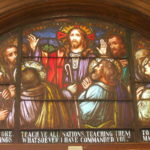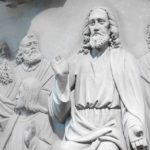Whenever a church organization is asked about their origins, most likely they will point to either Jesus Christ saying, “…Upon this rock I will build my church…” (Mt 16:18) or to Acts 2 in which the Holy Spirit came upon believers at Pentecost. However, when an unbeliever or sometimes even a person outside of that organization asks that the question, they are referring to the history of that organization and not the overall Church. So, the full question of the history of the Seventh-day Adventists could be phrased, “What are the modern origins of the church that calls itself ‘Seventh-day Adventist’?”
When the Puritans and other groups migrated to America in order to escape religious persecution, among these groups that desired to return back to “pure” religion, were seventh-day Sabbatarians. In other words, dotted along the landscape of New England were various small groups that kept the seventh day of the week, which is called Saturday on the modern calendar, as the weekly Sabbath.
This smaller group should not be confused with many who regarded Sunday as the Christian Sabbath and sometimes even referred to it as the Sabbath or more commonly “the Lord’s Day”. Many Puritans considered themselves Baptists, and some “Seventh Day Baptists” did not even consider themselves Puritans. This is worthy to note because often the lines of religious doctrine are laid out to appear clear-cut and non-overlapping when the reality is a bit messier.
History of the Seventh-day Adventist Church
In the 19th century, William Miller converted from Deism to become a Baptist, according to the Christian Apologetics and Research Ministry (CARM) article “The History of the Seventh-day Adventist Church”. Through intensive Bible study, he became convinced that Jesus Christ would return in 1843 based upon Daniel 8:14, which states the sanctuary would be cleansed after 2,300 days. Miller used the “day for a year” reckoning to figure that meant Christ would return after 2,300 years.
 At first, he was quite vague about the dates, but based upon the Jewish year, he narrowed his reckoning to 1843 – 1844. However, the beginning of Nisan, the first month of the religious year, passed without incident. He then revised it to 22 October 1844.
At first, he was quite vague about the dates, but based upon the Jewish year, he narrowed his reckoning to 1843 – 1844. However, the beginning of Nisan, the first month of the religious year, passed without incident. He then revised it to 22 October 1844.
What is interesting isn’t so much that someone predicted Christ’s return and the failed, for that has occurred time and time again in the history of Christianity, but the amazing thing is that Christ’s return to the earth was actually a novel idea. Most of Christianity in the early part of the century did not teach this. From Adventist.org, we read in the article “Seventh-Day Adventist Church Emerged From Religious Fervor of 19th Century” that, “By the 19th Century, most established churches were preaching that the Second Coming was more myth than reality—and more human than divine. Religious leaders taught that a metaphorical “second coming” symbolized the rise of a new God-fearing, socially responsible generation.”
Evangelicals today would take it for granted that Jesus Christ will literally return to this earth, so it might be quite surprising to learn that this belief was not always so prevalent. As a whole, Adventists were considered the odd lot, and some were even kicked out of their church congregations for believing in the second coming. On the website of the New Hampshire Seventh-day Adventist Church, in the article “Millerite Movement”, one can read, “In the face of the growing hostility in the churches, some Millerites questioned whether they should enter or remain in such churches, and others found themselves shut out.”
The only thing that truly united this group initially, however, was the belief in Christ returning and when. Miller himself, for example, was a Sunday keeping Baptist. The Adventists were from various churches, and the movement was originally considered interdenominational.
After the Great Disappointment, however, many return to their former organizations, and some quit religion altogether. However, there still was a scattering of Adventist believers across America who held fast to the belief that Christ would indeed return one day.
The morning of 23 October says Hiram Edson claiming that he saw a vision of Christ standing at the heavenly altar. This, he concluded, meant that the date was right about cleansing the sanctuary but the place was wrong. The sanctuary to be cleansed, he argued, was the one in Heaven not on earth. This was promoted by others, including a young Methodist named Ellen Harmon, who later married James White. According to the Adventist website in “Seventh-day Adventist Church Emerged from Religious Fervor of 19th Century”, she saw a vision in December 1844 that confirmed Edson’s interpretation of events.
 However, for many years, the Adventists had no real organization. The need for organization was finally realized over time when some of their missionaries could not even afford to eat. Their choice was to either work or preach, but they could not afford to do both. It wasn’t until 1860 that the name “Seventh-day Adventist” was chosen.
However, for many years, the Adventists had no real organization. The need for organization was finally realized over time when some of their missionaries could not even afford to eat. Their choice was to either work or preach, but they could not afford to do both. It wasn’t until 1860 that the name “Seventh-day Adventist” was chosen.
It should be noted that not all Adventist Sabbatarians followed Ellen G White’s group for various reasons. In particular, the Church of God (Seventh-Day) rejected her teachings as well as rejecting any other name than “Church of God”. From the Church of God (Seventh-Day) came Herbert W Armstrong, who also believed the church should be called the “Church of God” and founded the Worldwide Church of God.
In addition, not all Adventists became Sabbatarians. Various Adventist groups still worship on Sunday, including the Christadelphians and the Church of God General Conference.
The formal organization seemed repugnant to the early Seventh-day Adventists, as their point of focus was to come out of the world and its way of organizing. However, James White argued that “structure was a gauge of good stewardship”, and printed as much in the 1860 issue of their periodical.
One solid takeaway from this should be that sometimes bad things happen for good reasons. The Great Disappointment forced many to study their Bibles for themselves rather than simply believe what they had always been taught. Out of the dust of the chaos, confusion and even the violence that followed it, the Seventh-day Adventists were the largest organization to successfully rise to the challenges before them.






